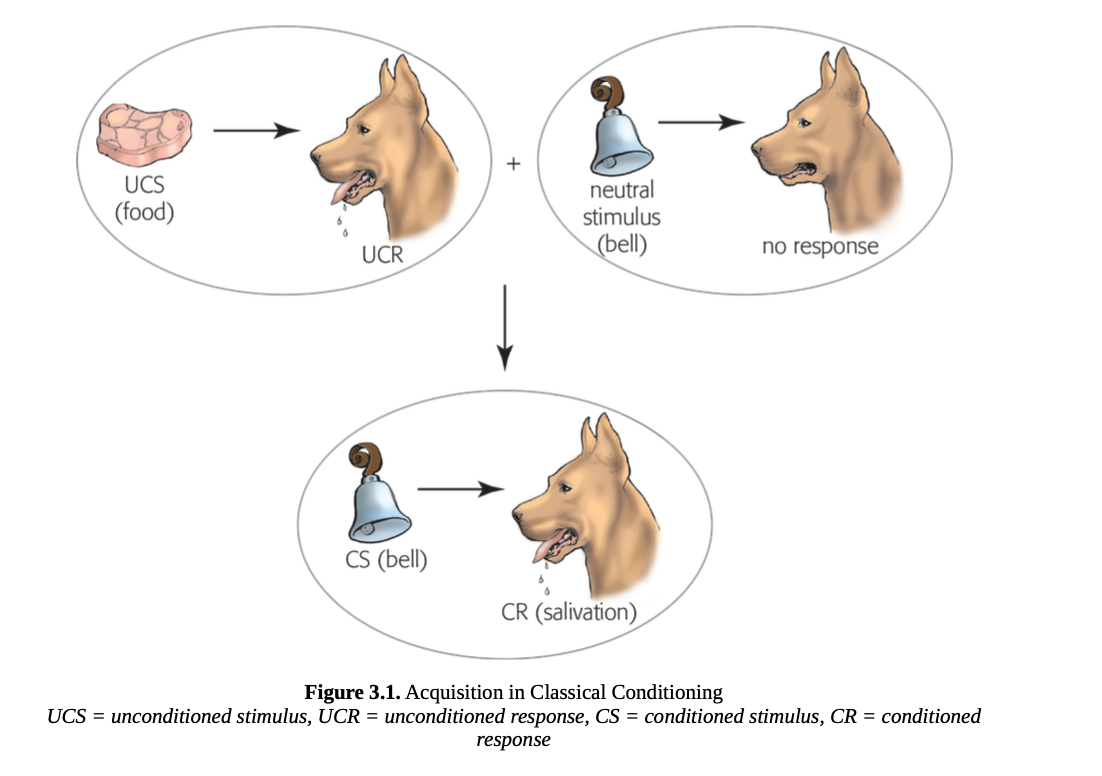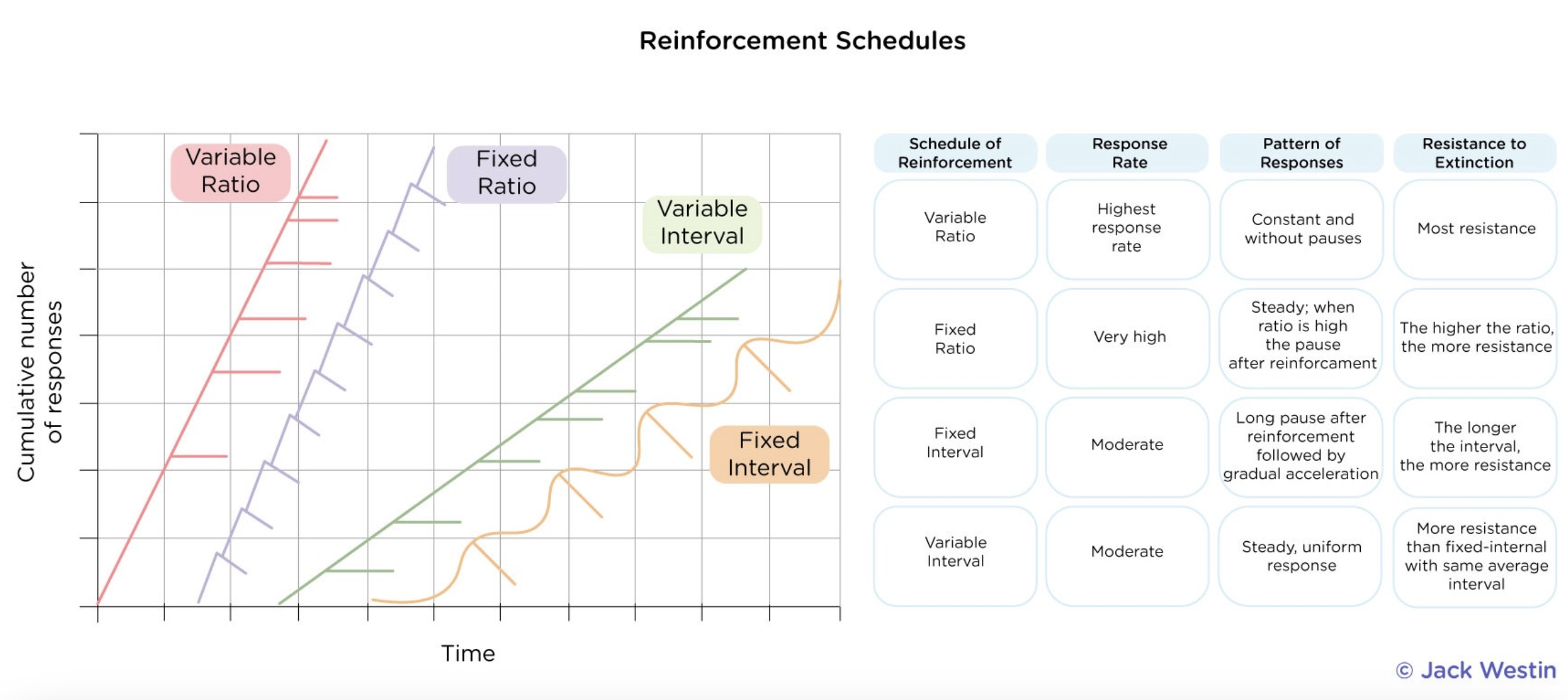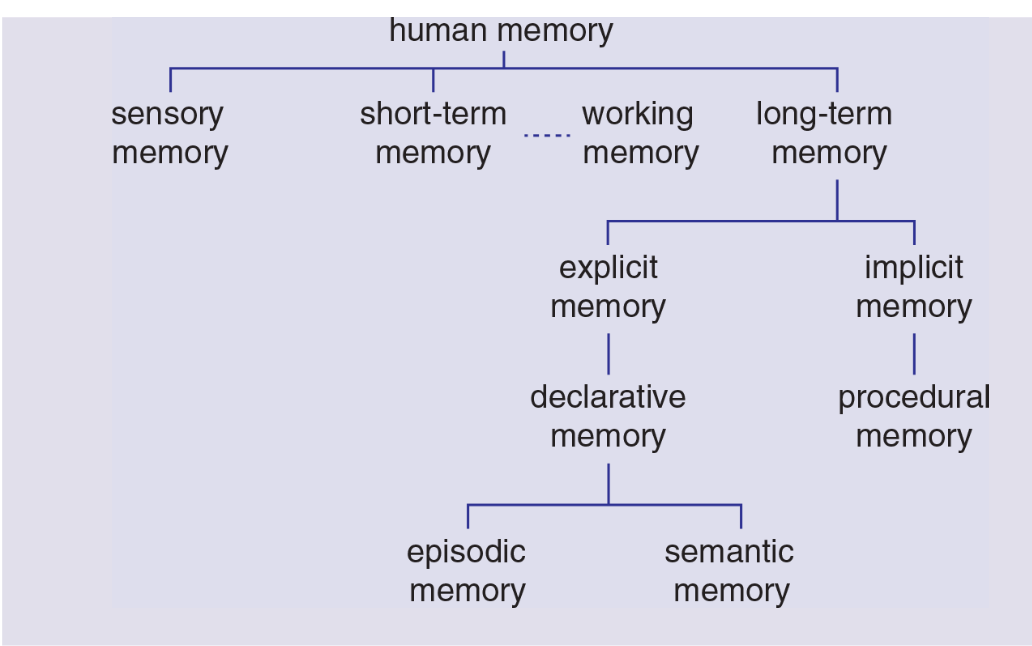PSY 1.3 Learning and Memory
1/81
There's no tags or description
Looks like no tags are added yet.
Name | Mastery | Learn | Test | Matching | Spaced |
|---|
No study sessions yet.
82 Terms
learning
acquisition of new behaviours
stimulus
can be defined as anything to which an organism can respond
habituation
is the process of becoming used to a stimulus.
dishabituation
can occur when a second stimulus intervenes, causing a resensitization to the original stimulus.
subthreshold stimulus
a stimulus too weak to elicit a response
associative learning
is a way of pairing together stimuli and responses, or behaviors and consequences.
include classical and operant conditioning

classical conditioning
associative learning that takes advantage of biological, instinctual responses to create associations between two unrelated stimuli.
an unconditioned stimulus that produces an instinctive,
unconditioned response is paired with a neutral stimulus. With repetition, the neutral stimulus becomes a conditioned stimulus that produces a conditioned response.
extinction
refers to the loss of a conditioned response
spontaneous recovery
the reappearance of a previously extinguished conditioned response after a period of time has passed since the conditioned stimulus (CS) was last presented
stimulus generalisation
a broadening effect by which a stimulus similar enough to the conditioned stimulus can also produce the conditioned response
stimulus discrimination
an organism learns to distinguish between similar stimuli
operant conditioning
behavior is changed through the use of consequences.
reinforcement
increases the likelihood of a behavior.
postive reinforcement
increase the frequency of a behavior by adding a positive consequence or incentive following the desired behavior.
negative reinforcement
they increase the frequency of a behavior, but they do so by removing something unpleasant.
eg escape and avoidance learning
escape learning
describes a situation where the organism experiences the unpleasant stimulus and in response displays a the desired behaviour to escape the stimulus
avoidance learning
occurs when the organism displays the desired behaviour in anticipation of the unpleasant stimulus, thereby avoiding the unpleasant stimulus
punishment
decreases the likelihood of a behavior.
positive punishment
adds an unpleasant consequence in response to a behavior to reduce that behavior;
for example, receiving a ticket and having to pay a fine for parking illegally.
negative punishment
removing a stimulus in order to cause reduction of a behavior.
For example, a parent or guardian may forbid a child from watching television as a consequence for bad behavior, with the goal of preventing the behavior from happening again.
reinforcement schedules

fixed ratio
reinforce a behavior after a specific number of performances of that behavior
variable ratio
reinforce a behavior after a varying number of performances of the behavior, but such that the average number of performances to receive a reward is relatively constant
fixed intervals
reinforce the first instance of a behavior after a specified time period has elapsed. For example, once our rat gets a pellet, it has to wait 60 seconds before it can get another pellet
variable interval
reinforce a behavior the first time that behavior is performed after a varying interval of time
The schedule of reinforcement affects the rate at which the behavior is performed. Behaviors learned through variable-ratio schedules are the hardest to extinguish.
shaping
which is the process of rewarding increasingly specific behaviors that become closer to a desired response
instinctual drift
When animals revert to an instinctive behavior after learning a new behavior
observational learning
process of learning a new behavior or gaining information by watching others
eg Albert Bandura Bobo dall experiment
memory

encoding
is the process of putting new information into memory. It can be automatic or effortful.
automatic processing
Information gained without any effort is the result, information is passively absorbed from the environment
semantic encoding is stronger than both acoustic and visual encoding.

self reference effect
we tend to recall information best when we can put it into the context of our own lives
maintenance rehearsal
which is the repetition of a piece of information to either keep it within working memory (to prevent forgetting) or to store it in short-term and eventually long-term memory
mnemonics
common way to memorize information, particularly lists
method of loci
involves associating each item in a list with a location along a route through a building that has already been memorized
peg word system
associates numbers with items that rhyme with or resemble the numbers
eg. one might be associated with the sun, two with a shoe, three with a tree, and so on
chunking
memory trick that involves taking individual elements of a large list and grouping them together into groups of elements with related meaning. For example, consider the following list of 16 letters: E-N- A-L-P-K-C-U-R-T-R-A-C-S-U-B.
Memorizing the list in order by rote might prove difficult until we realize that we can reverse the items and group them into meaningful chunks: BUS, CAR, TRUCK, PLANE
storage
Following encoding, information must be stored if it is to be remembered
Sensory memory
which preserves information in its original sensory form (auditory, visual, etc.) with high accuracy and lasts only a very short time, generally less than one second.
includes iconic and echoic memory
iconic memory
fast decaying memory visual stimuli
echoic memory
fast decaying memory of auditory stimuli
short term memory
Similar to sensory memory, short-term memory fades quickly, over the course of approximately 30 seconds without rehearsal.
limited to approximately seven items,usually stated as the 7 ± 2 rule
stored in the hippocampus
working memory
supported by the hippocampus
it enables few pieces of information in our consciousness simultaneously and to manipulate that information
eg able to fit unfinished puzzle together mentally
long term memory
essentially limitless warehouse for knowledge that we are then able to recall on demand, sometimes for the rest of our lives.
requires elaborative rehearsal and is the result of increased neuronal connectivity.
elaborative rehearsal
is the association of the information to knowledge already stored in long-term memory
explicit (declarative) memory
consists of those memories that require conscious recall.
include episodic and semantic memory
episodic memory
refers to our recollection of life experiences
semantic memory
refers to ideas, concepts, or facts
autobiographical memory
is the name given to our explicit memories about our lives and ourselves, and includes all of our episodic memories of our own life experiences, but also includes semantic memories that relate to our personal traits and characteristics
flashbulb memory
a vivid and exceptionally detailed memory associated with a shocking or emotionally significant event, often including details about the time and place of the event.
implicit (non declarative) memory
stores skills and conditioning effects none of which need to be consciously recalled
includes procedural memory and priming
procedural memory
which relates to our unconscious memory of the skills required to complete procedural tasks
priming
involves the presentation of one stimulus affecting perception of a second
positive priming
occurs when exposure to the first stimulus improves processing of the second stimulus, as demonstrated by measures such as decreased response time or decreased error rate.
negative priming
the first stimulus interferes with the processing of the second stimulus, resulting in slower response times and more errors
long-term potentiation
responsible for the conversion of short-term to long-term memory, is the strengthening of neuronal connections resulting from increased neurotransmitter release and adding of receptor sites.
retrieval
is the name given to the process of demonstrating that something that has been learned has been retained
eg recall
recognition
process of merely identifying a piece of information that was previously learned, is far easier than recall
semantic network
the way in which the brain organises ideas which are linked together based on similar meaning
source monitoring
is a part of the retrieval process that involves determining the origin of memories, and whether they are factual (real and accurate) or fictional (from a dream, novel, or movie).
state dependent memory
retrieval cue based on performing better when in the same mental state as when the information was learned.
eg. People who learn facts or skills while intoxicated, for example, will show better recall or proficiency when performing those same tasks while intoxicated as compared to performing them while sober.
primacy effect
tendency to remember things earlier on
recency effect
tendency to remember things later on
amnesia
forgetting
source amnesia
inability to remember where, when, or how one has obtained knowledge
retrograde amnesia
the loss of previously formed memories
anterograde amnesia
the inability to form new memories
confabulation
process of creating vivid but fabricated memories, typically thought to be an attempt made by the brain to fill in the gaps of missing memories.
agnosia
is the loss of the ability to recognize objects, people, or sounds, though usually only one of the three. Agnosia is usually caused by physical damage to the brain, such as that caused by a stroke or a neurological disorder such as multiple sclerosis
proactive interference
old information is interfering with new learning
retroactive interference
new information causes forgetting of old information
prospective memory
remembering to perform a task at some point in the future
eg remembering to take medication at 7am
reproductive memory
accurate recall of past events
reconstructive memory
explains how two people can recall the same event as occurring in completely different ways.
false memory
A memory that incorrectly recalls actual events or recalls events that never occurred
misinformation effect
person’s recall of an event becomes less accurate due to the injection of outside information into the memory
intrusion errors
refers to false memories that have included a false detail into a particular memory.
This is similar to the misinformation effect but distinct in that the intrusion error is not from an outside source. Instead, the intruding memory is injected into original memory due to both memories being related or sharing a theme.
source monitoring error
involves confusion between semantic and episodic memory: a person remembers the details of an event, but confuses the context under which those details were gained.
Source-monitoring error often manifests when a person hears a story of something that happened to someone else, and later recalls the story as a personal memory.
neuroplasticity
our brains develop, neural connections form rapidly in response to stimuli
synaptic pruning
weak neural connections are broken while strong ones are bolstered, increasing the efficiency of our brains’ ability to process information.